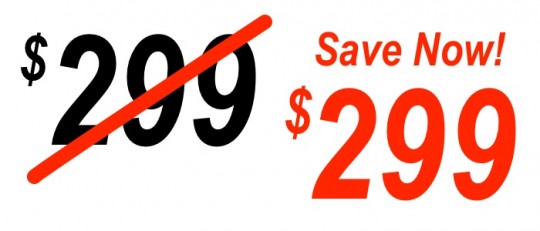A Super-Simple Way to Make Your Prices Seem Lower… With One Catch
 Want to make your prices seem lower without actually changing them? I’ve got a research-based technique that will do exactly that, with one small catch: your prices will only look lower to your male customers.
Want to make your prices seem lower without actually changing them? I’ve got a research-based technique that will do exactly that, with one small catch: your prices will only look lower to your male customers.
 In a study titled Are Men Seduced by Red? The Effect of Red Versus Black Prices on Price Perceptions, researchers in the U.K. and U.S. describe a series of experiments on color and pricing.
In a study titled Are Men Seduced by Red? The Effect of Red Versus Black Prices on Price Perceptions, researchers in the U.K. and U.S. describe a series of experiments on color and pricing.
For men, the perceived savings when prices were printed in red were about twice as high as when they were printed in black. Women, however, were mostly unaffected by the color of the price.
The effect was less pronounced when the male subjects were highly engaged in the shopping task. So, using red prices will be most effective for impulse purchases vs. well-researched buys, like cars or high-end cameras.
While the perceived savings difference is small in percentage terms, it seems possible that it could have an outsized effect on casual shoppers who would perceive that one merchant is cheaper even though the actual prices are the same.
Once again, the study shows, women are superior to men at not being influenced by irrelevant factors in an advertisement. (See A Pretty Woman Beats a Good Loan Deal and Sexy Pictures and Gender Differences for more examples of male susceptibility.)
The good news for marketers is that using red prices won’t hurt the ad’s appeal to women, so they can appeal to male customers without decreasing sales to females.
What color are your prices now? If you make a change, share your results in a comment!

This effect might be related to the fact that 1 out of 12 men is red-green colorblind, while almost no women are.
To a colorblind man, the red would look gray. Why that might affect his price perception is unclear.
Interesting theory, Miles, but there’s a ton of literature documenting the red effect in various domains. Nary a word of a “gray effect.” You raise an interesting point, though. While few males are truly colorblind, many suffer from moderate forms of red-green color blindness that makes those colors harder to resolve. It would be a good experiment to test the red effect (on prices or something else) with a spectrum (no pun intended) of color-challenged males.
Great post here Roger!
I have used red for my pricing a lot and as you say it has proved to be very successful. Another tactic I have used is the power of 7! I have found this really interesting as everyone now seems to be aware that companies use the number 9 to make something sound cheaper but 7 seems an all new thing to most buyers…. With the number 7 at the end of the price (97.00) or (27.00, etc) and then putting that in red it would be very interesting to see the outcome!
Thanks again for the helpful post.
Very interesting, Nathan. For years, Sears used “7” at the end of their prices. They were one of the most sophisticated direct marketers at the time, so presumably they found that it outperformed “9” with their target market.
Interesting idea. I’ll definitely try this out on my next project and see if there are any noticeable improvements.
Super interesting concept to test, we ran a couple experiments isolating just red vs black and saw an increase in revenue. Thanks for the tips Roger!
That’s great, thanks for sharing, Luiz!
I really did not believe this, when I first saw this 4 days ago. BUT GUESS WHAT, tried it for the past 3 days and had an increase of 24% in sales. Might be just a spike but oh well before I forget to comment on this, i just wanted to share!
Glad this (apparently) worked for you, John!